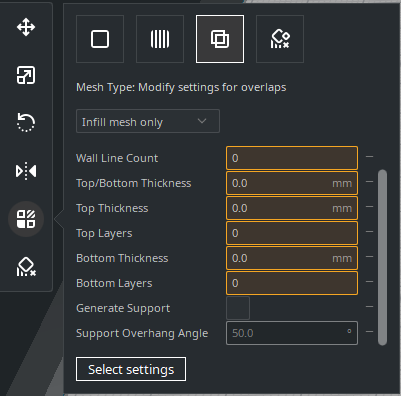GregValiant 1,330
If that is a typical threadform with 60° included angle then setting the "Support Overhang Angle" to something over 60° will keep Cura from adding support to the threads. On some models support may become sketchy in other areas, but the threads should be unsupported. Since your overhang is at 90° it will remain supported.
The shape below is angled at 30°. That also means it's at 60° from the vertical which is the Support Overhang Angle. In the main settings I have Support Overhang Angle set to 59° and so the whole thing would be supported. Then (as @43915 describes) I brought in a support blocker, set it as a "Cutting Mesh" and to "Modify Settings for Overlaps", and added the setting "Support Overhang Angle" with it set to 61°. The area covered by the support blocker is now unsupported.
You shouldn't need to do that for your model though. Just set the the Support Overhang Angle to 61° and you should be good.









Recommended Posts
43915 18
I'm not sure if it's the best way to get around the problem, but when I have a model where I want support on a specific area and not the rest of the print (or the other way around) I just add another model like a simple cube for example. Then I go to to the "per model settings" and enable "modify settings for overlaps" for the cube which lets you change the print settings where that model overlaps other models. And then, if you disable the "automatically drop models to the build plate" setting you can just scale the cube and move it to fit the area you want and change the support settings for that overlap. You might have to click on "Select settings" and look for the support settings in the list if they're not already visible.
So in your case I would make and add a cylider shaped model and scale it to precisely fit the threads on your model where you don't want any support and disable supports in the settings for those overlaps while enabling supports for the main model.
This also works for other settings like infill, so if you want more or less infill on a specific area of a model you can use this method as well.
I wouldn't be surprised if there are easier ways to deal with this kind of thing, but that's how I usually do it.

Edited by 43915Link to post
Share on other sites